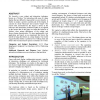UIST
2004
ACM
14 years 5 months ago
2004
ACM
In this paper, we explore the concept of dual–purpose speech: speech that is socially appropriate in the context of a human– to–human conversation which also provides meanin...
UIST
2004
ACM
14 years 5 months ago
2004
ACM
Location-enhanced applications use the location of people, places, and things to augment or streamline interaction. Location-enhanced applications are just starting to emerge in s...
UIST
2004
ACM
14 years 5 months ago
2004
ACM
Visual tracking of bare fingers allows more direct manipulation of digital objects, multiple simultaneous users interacting with their two hands, and permits the interaction on l...
UIST
2004
ACM
14 years 5 months ago
2004
ACM
Projection technology typically places several constraints on the geometric relationship between the projector and the projection surface to obtain an undistorted, properly sized ...
UIST
2004
ACM
14 years 5 months ago
2004
ACM
This paper presents an approach for tracking paper documents on the desk over time and automatically linking them to the corresponding electronic documents using an overhead video...
UIST
2004
ACM
14 years 5 months ago
2004
ACM
We describe a new widget and interaction technique, known as a “Frisbee,” for interacting with areas of a large display that are difficult or impossible to access directly. A ...
UIST
2004
ACM
14 years 5 months ago
2004
ACM
A long standing challenge in pen-based computer interaction is the ability to make sense of informal sketches. A main difficulty lies in reliably extracting and recognizing the i...
UIST
2004
ACM
14 years 5 months ago
2004
ACM
We present content-aware free-space transparency, an approach to viewing and manipulating the otherwise hidden content of obscured windows through unimportant regions of overlappi...
UIST
2004
ACM
14 years 5 months ago
2004
ACM
UIST
2004
ACM
14 years 5 months ago
2004
ACM
Light Emitting Diodes (LEDs) offer long life, low cost, efficiency, brightness, and a full range of colors. Because of these properties, they are widely used for simple displays i...


